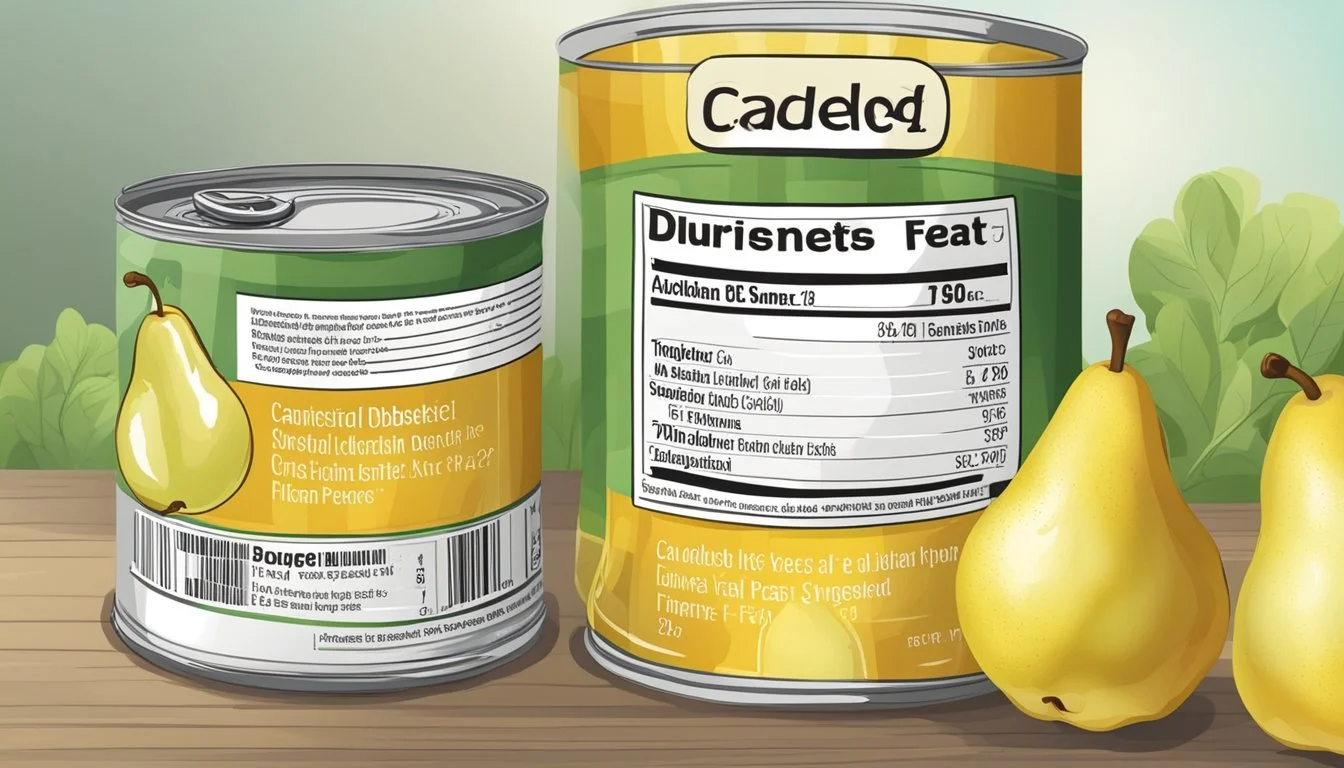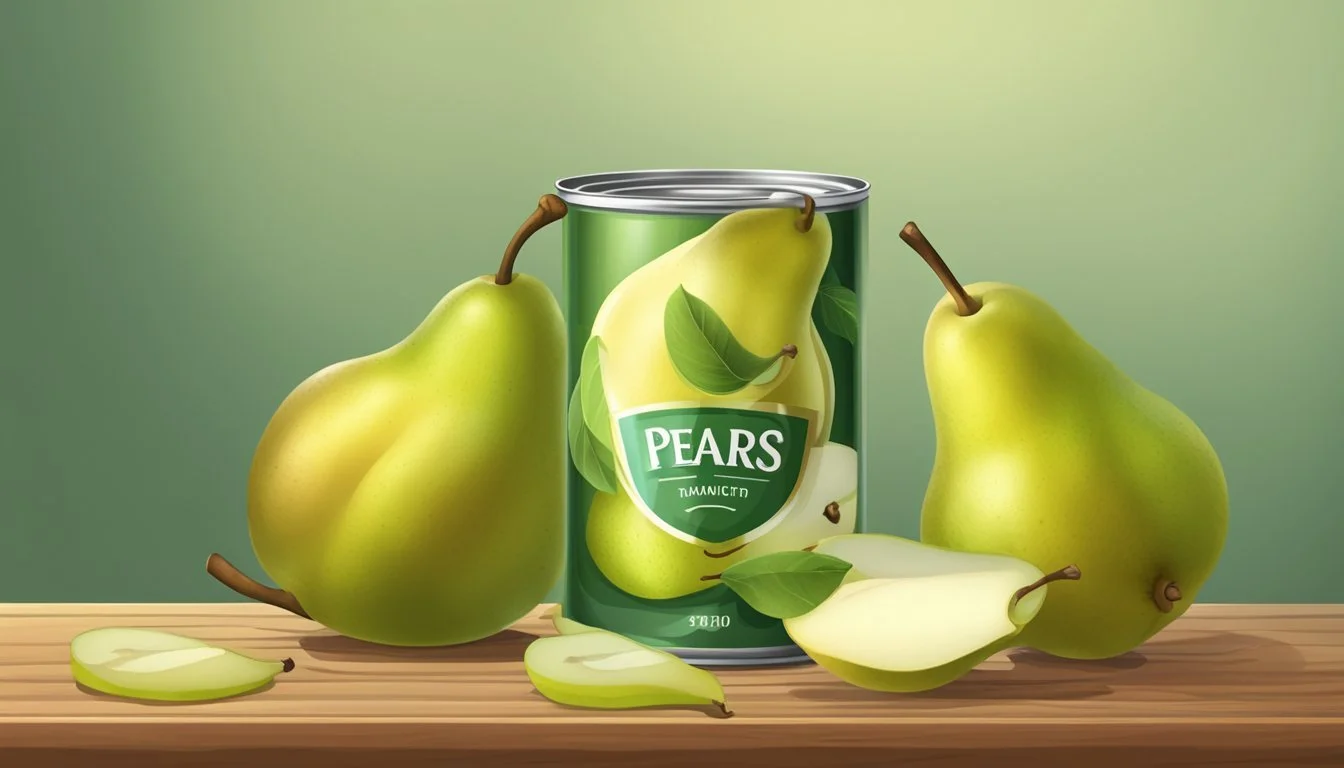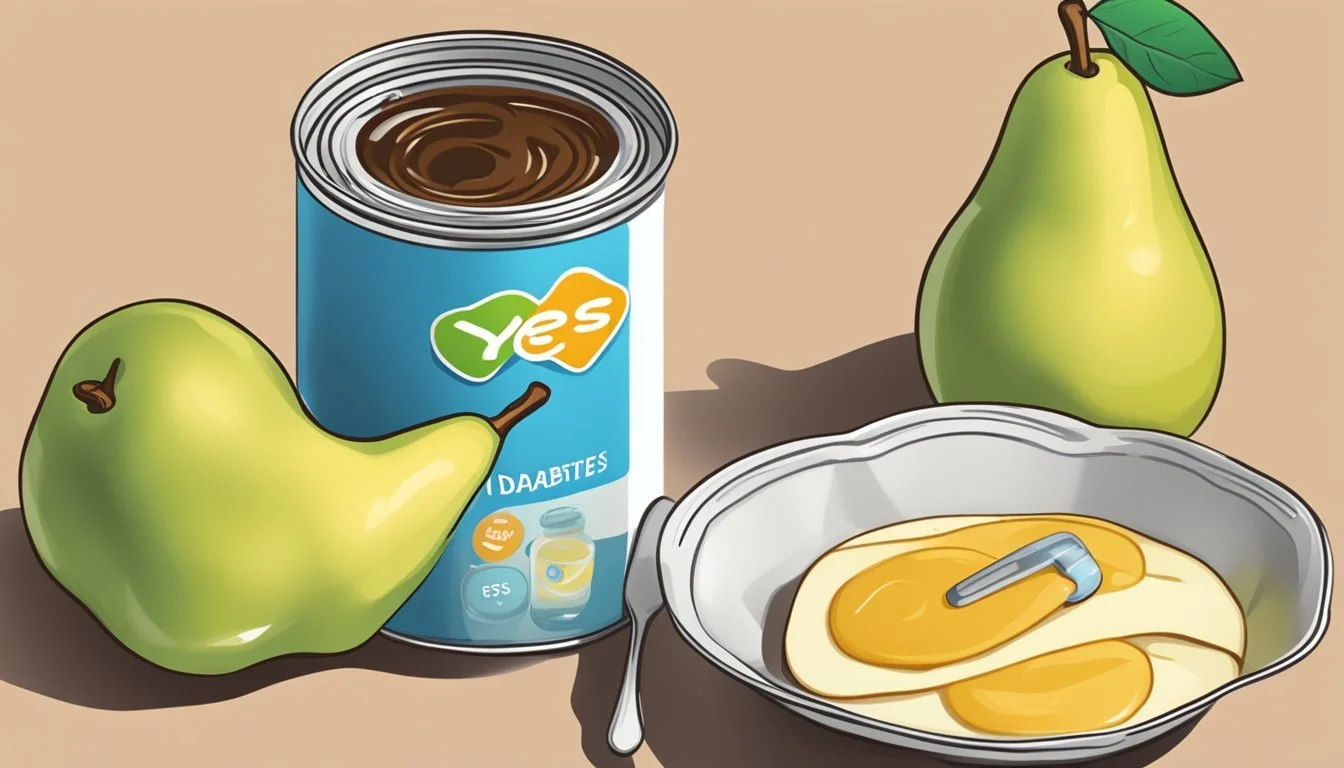Can Diabetics Eat Canned Pears in Syrup?
Dietary Considerations and Tips
Canned pears in syrup can be a convenient and tasty option, but they come with certain considerations for individuals with diabetes. Fresh fruit is typically preferred due to its lower sugar content. For those managing diabetes, it’s essential to avoid canned pears packed in heavy syrup since the added sugars can elevate blood glucose levels. Instead, choosing canned pears that are packed in water or their own juice can be a better alternative.
Eating fruit is crucial for a balanced diet, even for people with diabetes. Pears, in particular, offer a variety of health benefits, and they can be a nutritious addition due to their fiber and nutrient content. Canned fruits have a long shelf life and can be more cost-effective, making them a practical choice when fresh options are unavailable.
Opting for fruits without added sugars ensures that individuals with diabetes can still enjoy them without adverse effects on their blood sugar levels. It's important to read labels carefully and select canned fruits that align with a diabetes-friendly diet. By making informed choices, anyone can incorporate the goodness of pears into their daily meals.
Understanding Diabetes and Diet
Managing diabetes requires careful attention to diet, particularly the impact of carbohydrates on blood sugar levels and the role of the glycemic index in choosing foods. Here's a detailed examination of these concepts.
Impact of Carbohydrates on Blood Sugar
Carbohydrates significantly affect blood sugar levels. When consumed, carbohydrates are broken down into glucose, which enters the bloodstream. For people with diabetes, monitoring carbohydrate intake is essential because it directly influences blood glucose levels.
Consuming high-carbohydrate foods can lead to a rapid spike in blood sugar. This requires increased insulin to help manage these levels. For those with type 2 diabetes, the body's response to insulin can be impaired, making carbohydrate management even more crucial.
Common sources of carbohydrates:
Breads and grains
Fruits
Sugary foods and drinks
A balanced diet, including complex carbohydrates like whole grains, can provide steady energy without causing significant blood sugar fluctuations.
The Role of the Glycemic Index
The glycemic index (GI) measures how quickly a carbohydrate-containing food raises blood sugar levels compared to pure glucose. Foods with a high GI cause rapid spikes in blood sugar, while those with a low GI have a slower, more gradual effect.
For diabetics, choosing low-GI foods can help maintain stable blood sugar levels. Low-GI foods include many fruits, vegetables, and whole grains.
Examples of low-GI foods:
Legumes
Non-starchy vegetables
Some fruits (e.g., apples, pears)
Understanding GI values can assist in making more informed dietary choices, promoting better blood sugar control and overall diabetes management.
Nutritional Profile of Canned Pears
Canned pears can be a convenient option for those managing diabetes, but their nutritional value can differ significantly based on how they are prepared, especially in syrup. Here, the focus is on the nutritional differences between fresh and canned pears and the impact of syrup content.
Comparison to Fresh Pears
Fresh pears are rich in nutrients such as dietary fiber, vitamins, and minerals. They typically contain 6 grams of fiber, 12 mg of Vitamin C, and are low in calories, with about 100 calories per medium pear.
Canned pears, on the other hand, retain many of these beneficial nutrients. However, some vitamins, especially Vitamin C, might be reduced during the canning process. Despite this, they still provide essential nutrients like potassium and magnesium.
Nutrient Fresh Pear Canned Pear (in juice) Fiber (grams) 6 4 Vitamin C (mg) 12 1 Calories 100 70
Analyzing Syrup Content
Canned pears can come in various types of syrup, including heavy syrup, light syrup, or their own juice. Pears canned in heavy syrup add a significant amount of added sugar, which can impact blood glucose levels.
For instance, pears in heavy syrup can add an extra 10-20 grams of sugar per serving, raising concerns for people with diabetes. Opting for pears canned in their own juice or water is a better choice, as it avoids these additional sugars while preserving the fruit’s natural flavors and nutrients.
Summary of Syrup Impacts:
Heavy Syrup: High in added sugars, increases calorie content.
Light Syrup: Lower in added sugars but still higher than pears canned in juice or water.
Own Juice/Water: No added sugars, retains most of the nutritional benefits of fresh pears without impacting blood glucose significantly.
Health Considerations for Diabetics
Individuals with diabetes must be vigilant about their sugar intake and embrace foods that help manage blood glucose levels. Canned pears in syrup pose specific concerns due to added sugars, which affect health differently than fresh fruit.
Monitoring Sugar Intake
For diabetics, it is crucial to monitor sugar intake and choose foods that support stable blood sugar levels.
Canned pears in syrup often contain added sugars, which can spike blood glucose levels. High blood sugar can lead to complications such as heart disease and nerve damage. Opting for pears canned in their own juice or water is a healthier alternative, reducing unnecessary sugar consumption.
Reading labels carefully is essential. Diabetics should aim for options that list unsweetened or no added sugar to minimize negative impacts on glucose levels. Consistently high sugar intake can also contribute to increased caloric intake, affecting weight and overall health.
Benefits of Fiber in Diabetes Management
Fiber plays a vital role in diabetes management by moderating blood glucose levels and promoting heart health.
Pears are rich in dietary fiber, particularly soluble fiber, which slows glucose absorption. This helps in maintaining steady blood sugar levels. Including fiber-rich foods can also aid in achieving a healthy weight, a key factor in diabetes control.
Additionally, the fiber in pears may help lower cholesterol levels, reducing the risk of heart disease. Diabetics often benefit from foods with a low glycemic index (GI), and pears, particularly when consumed as whole fruit rather than in syrup, fit this category. This makes pears a favorable option for maintaining balanced glucose levels and overall health.
Integrating Canned Pears into a Diabetic Meal Plan
Canned pears can be a healthy addition to a diabetic meal plan when consumed in moderation. The focus should be on maintaining balanced meals and monitoring portion sizes to keep blood sugar levels stable.
Creating Balanced Meals
Incorporating canned pears into a diabetes-friendly meal plan involves balancing them with other nutrient-dense foods. Pairing canned pears with sources of protein and fiber, such as Greek yogurt or cottage cheese, can help slow the absorption of carbohydrates. This combination can prevent blood sugar spikes.
For main meals, consider adding canned pears to a salad with leafy greens, nuts, and a lean protein like chicken. This creates a varied and balanced dish. When selecting canned pears, choose those packed in water or their own juice, not in syrup, to avoid added sugars.
Portion Sizes and Frequency
Portion control is crucial when including canned pears in a diabetic meal plan. A standard serving size might be half a cup, but checking specific nutritional labels is important. Consuming too much at once can lead to undesirable blood sugar levels.
Limit the frequency of consuming canned pears to a few times a week rather than daily. Incorporating a variety of fruits and other carbs ensures a more balanced intake of nutrients. By paying attention to serving sizes and mixing with proteins or high-fiber foods, individuals can enjoy canned pears without compromising their dietary goals.
In summary, keeping a focus on balance and moderation helps integrate canned pears seamlessly into a diabetes meal plan.
Alternatives to Canned Pears in Syrup
Diabetics looking to manage their blood sugar levels can consider other fruit options that offer better nutritional profiles, such as fresh or frozen fruits and certain types of canned fruits without added sugars.
Fresh and Frozen Fruit Options
Fresh fruit is often the best choice for diabetics, as it typically contains no added sugars. Fruits like berries, apples, pears, raspberries, pineapples, strawberries, blueberries, oranges, and apricots are excellent options. These fruits are low on the glycemic index compared to canned pears in syrup, making them safer choices for maintaining stable blood glucose levels.
Frozen fruit can be just as nutritious as fresh fruit. Freezing preserves the valuable nutrients without adding sugar, making options like frozen berries and pineapple suitable for those managing diabetes. Always check labels to ensure there are no added sugars or syrups.
Diabetes-Friendly Canned Fruit Choices
When fresh or frozen fruit isn’t available, diabetics can opt for canned fruit with no added sugar. Some canned fruits come in their own juice or packed in water, which are healthier alternatives to those packed in syrup. Reading labels is crucial to ensure they are unsweetened.
Canned fruits like pears, peaches, and apricots in 100% fruit juice or water-packed versions are preferable. These options provide essential nutrients without the risk of added sugars. Additionally, some canned fruits like unsweetened applesauce can be a good alternative, offering a lower glycemic index choice.
Choosing the right type of fruit can make a significant difference in maintaining blood sugar levels and overall health for diabetics.
Reading Nutrition Labels for Canned Fruits
Canned fruits can be a convenient and nutritious option if you know how to read their nutrition labels properly. Paying attention to added sugars and accurate serving sizes is key to making a healthier choice.
Understanding Added Sugars
When choosing canned fruits, it is crucial to check for added sugars. Canned fruits packed in heavy syrup typically contain significant amounts of added sugar, which can spike blood glucose levels. Opt for products labeled as "no added sugar" or those packed in their own juice or water.
Labels to look for:
Heavy Syrup: High levels of added sugar.
Light Syrup: Moderate levels of added sugar.
No Added Sugar: Best option, usually just the fruit's natural sugars.
Own Juice: Contains natural fruit sugars without added sugars.
Reading the nutrition label will reveal the total sugars and added sugars, helping you make an informed decision. Checking for the term "added sugars" helps differentiate between sugars naturally present in the fruit and those artificially added.
Deciphering Serving Sizes
Understanding serving size is essential to manage carbohydrate intake effectively. Nutrition labels usually list information based on per serving rather than the entire can. For canned fruits, a serving size is often about ½ cup.
Tips for serving size:
Verify the serving size listed on the label.
Calculate the number of servings per container if necessary.
Measure portion sizes to ensure accurate intake.
For diabetes management, keeping an eye on the carbohydrates per serving is critical. The recommended serving sizes for various fruits might differ, but the general guideline is around 15 grams of carbohydrate per serving.
Here is an example label breakdown:
Nutrient Amount per 1/2 cup serving Total Carbohydrates 15g Sugars 10g (including 5g added sugars) Serving per Container 4
This helps in managing overall carbohydrate intake and maintaining blood sugar levels. Paying attention to both serving sizes and added sugars can make canned fruits a viable option for diabetics.
Incorporating Fruits in Diabetes-Friendly Recipes
Fruits can be an essential part of a diabetes-friendly diet when used in the right ways. Recipes that incorporate fruits can provide delicious and nutritious options that satisfy cravings without spiking blood sugar levels.
Healthy Snack Ideas
For those looking for a quick, diabetes-friendly snack, combining fruits with protein and healthy fats is beneficial. A small bowl of Greek yogurt topped with fresh berries can be a satisfying option. Greek yogurt is high in protein, while berries provide fiber and natural sweetness.
Apple slices with almond butter offer a good balance of fiber and healthy fats. The fiber in apples helps manage blood sugar levels, while almond butter provides a dose of protein and healthy fat.
Another option is a fruit salad with a mix of your favorite diabetes-friendly fruits such as berries, kiwi, and a few slices of pear in its own juice or water. Sprinkling chia seeds over the salad can add an extra boost of fiber and omega-3 fatty acids.
Dessert Alternatives
Desserts can be tricky for diabetics, but incorporating fruits can make them both delicious and safe. Oatmeal pancakes with a topping of blueberries and a sprinkle of cinnamon can be a filling and sweet breakfast or dessert alternative. Oatmeal provides fiber, which helps keep blood sugar steady.
Another tasty dessert option is a simple baked pear. Slice a pear and bake it with a sprinkle of cinnamon and a drizzle of honey (if blood sugar levels are well-controlled). This dessert is naturally sweet and provides a healthy way to curb cravings.
Greek yogurt parfaits layered with fresh fruit and a few nuts not only satisfy a sweet tooth but also offer protein, healthy fats, and fiber. This combination helps manage blood sugar levels while still enjoying a sweet treat.
Incorporating these ideas can help maintain a balanced diet that is both enjoyable and diabetes-friendly.
Lifestyle and Dietary Tips for Managing Diabetes
Managing diabetes involves a combination of healthy eating and regular physical activity. The following tips focus on essential aspects like exercise, weight management, and strategies for reducing sugar intake to help keep blood sugar levels in check.
Exercise and Weight Management
Regular exercise is crucial for people with diabetes. Engaging in at least 150 minutes of moderate-intensity aerobic activity per week can help maintain a healthy weight. Activities like brisk walking, swimming, or cycling are excellent options.
Strength training twice a week can also improve insulin sensitivity. Tracking progress and setting realistic goals can be motivating and beneficial. A combination of aerobic exercise and strength training is most effective for blood sugar control.
Weight management is another key aspect. Maintaining a healthy weight can significantly reduce insulin resistance. Monitoring portion sizes, choosing whole grains over refined carbs, and including lean proteins in meals can support weight management efforts.
Strategies for Reducing Sugar Intake
Reducing sugar intake is essential for managing diabetes. Opting for whole fruits instead of fruit juices can prevent rapid blood sugar spikes. When consuming fruits like canned pears, choosing those packed in water or their own juice rather than syrup can minimize added sugars.
Reading food labels is critical. Identifying hidden sugars in processed foods and avoiding products with high fructose corn syrup can help manage sugar intake. Replacing sugary drinks with water or unsweetened beverages also makes a significant difference.
Incorporating more fiber-rich foods, such as vegetables, whole grains, and legumes, can slow down the absorption of sugars into the bloodstream. Additionally, balancing meals with an appropriate ratio of carbohydrates, proteins, and fats can prevent blood sugar fluctuations.
Through mindful eating and making informed food choices, individuals with diabetes can effectively reduce their sugar intake and manage their condition better.







